Comprehensive Report: Infant Lifespan Development Process and Stages
VerifiedAdded on 2022/08/11
|5
|1548
|33
Report
AI Summary
This report provides a comprehensive overview of the infant lifespan development process, encompassing physical, cognitive, and psychosocial aspects. It details the physical changes infants undergo, including weight gain, height increase, and the development of motor skills, while also exploring cognitive milestones such as learning, memory, and problem-solving abilities. The report further examines nutritional needs, sensory development, and prenatal stages, including the significance of natural labor and potential birth complications. It highlights the interplay of genetic and environmental factors in infant development, including the influence of maternal habits. Finally, the report touches upon newborn complications and the development of competent newborns, supported by relevant research and references.
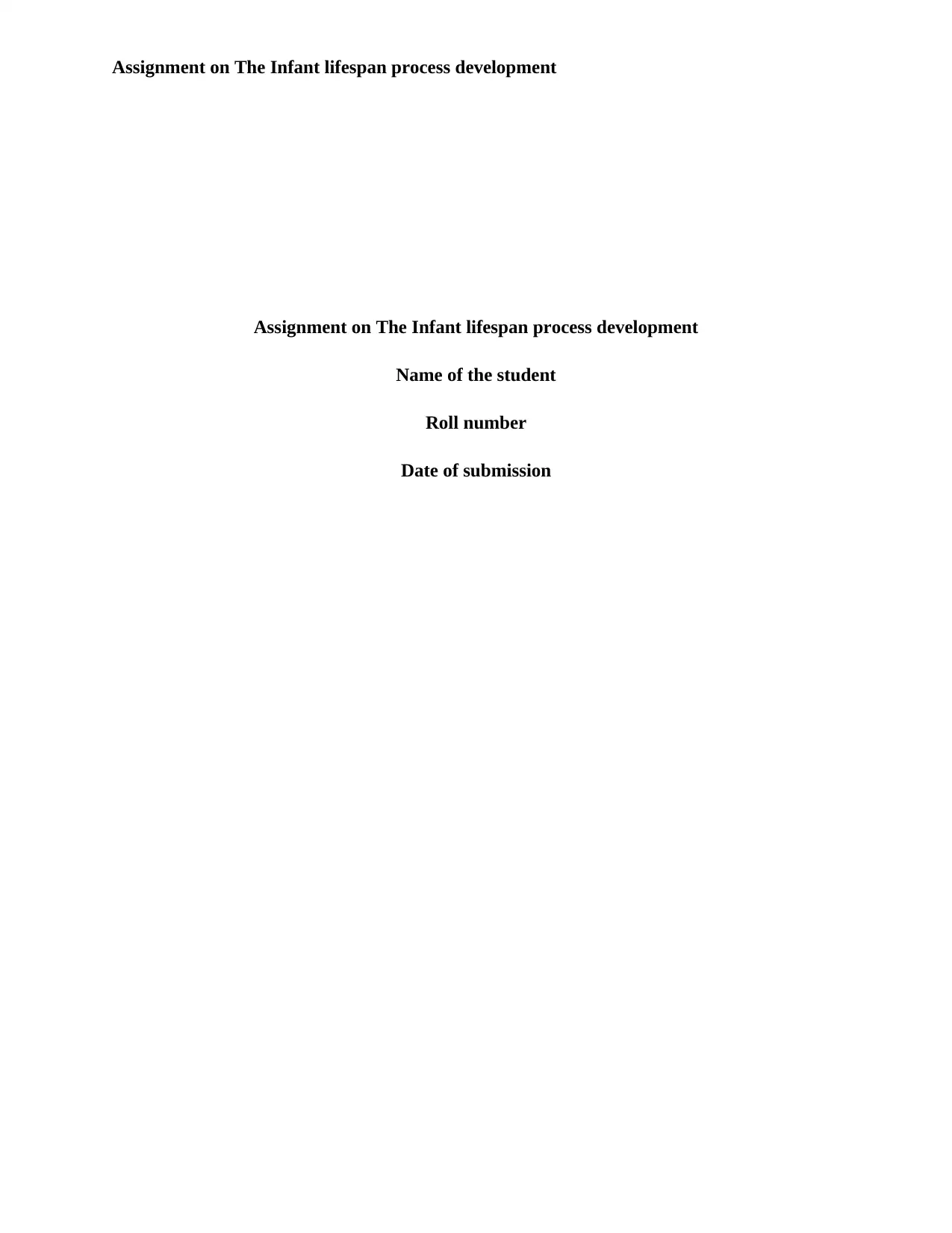
Assignment on The Infant lifespan process development
Assignment on The Infant lifespan process development
Name of the student
Roll number
Date of submission
Assignment on The Infant lifespan process development
Name of the student
Roll number
Date of submission
Paraphrase This Document
Need a fresh take? Get an instant paraphrase of this document with our AI Paraphraser
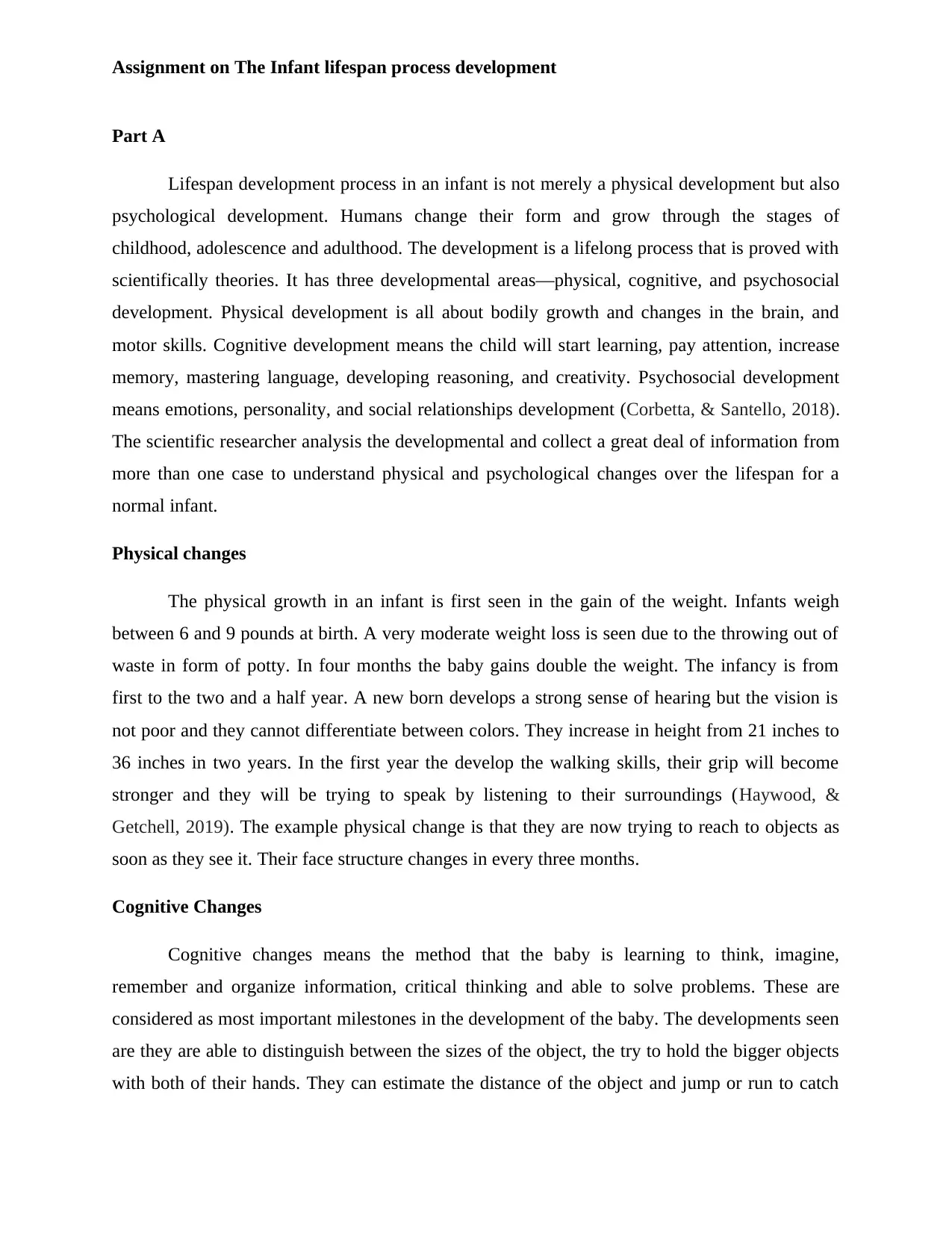
Assignment on The Infant lifespan process development
Part A
Lifespan development process in an infant is not merely a physical development but also
psychological development. Humans change their form and grow through the stages of
childhood, adolescence and adulthood. The development is a lifelong process that is proved with
scientifically theories. It has three developmental areas—physical, cognitive, and psychosocial
development. Physical development is all about bodily growth and changes in the brain, and
motor skills. Cognitive development means the child will start learning, pay attention, increase
memory, mastering language, developing reasoning, and creativity. Psychosocial development
means emotions, personality, and social relationships development (Corbetta, & Santello, 2018).
The scientific researcher analysis the developmental and collect a great deal of information from
more than one case to understand physical and psychological changes over the lifespan for a
normal infant.
Physical changes
The physical growth in an infant is first seen in the gain of the weight. Infants weigh
between 6 and 9 pounds at birth. A very moderate weight loss is seen due to the throwing out of
waste in form of potty. In four months the baby gains double the weight. The infancy is from
first to the two and a half year. A new born develops a strong sense of hearing but the vision is
not poor and they cannot differentiate between colors. They increase in height from 21 inches to
36 inches in two years. In the first year the develop the walking skills, their grip will become
stronger and they will be trying to speak by listening to their surroundings (Haywood, &
Getchell, 2019). The example physical change is that they are now trying to reach to objects as
soon as they see it. Their face structure changes in every three months.
Cognitive Changes
Cognitive changes means the method that the baby is learning to think, imagine,
remember and organize information, critical thinking and able to solve problems. These are
considered as most important milestones in the development of the baby. The developments seen
are they are able to distinguish between the sizes of the object, the try to hold the bigger objects
with both of their hands. They can estimate the distance of the object and jump or run to catch
Part A
Lifespan development process in an infant is not merely a physical development but also
psychological development. Humans change their form and grow through the stages of
childhood, adolescence and adulthood. The development is a lifelong process that is proved with
scientifically theories. It has three developmental areas—physical, cognitive, and psychosocial
development. Physical development is all about bodily growth and changes in the brain, and
motor skills. Cognitive development means the child will start learning, pay attention, increase
memory, mastering language, developing reasoning, and creativity. Psychosocial development
means emotions, personality, and social relationships development (Corbetta, & Santello, 2018).
The scientific researcher analysis the developmental and collect a great deal of information from
more than one case to understand physical and psychological changes over the lifespan for a
normal infant.
Physical changes
The physical growth in an infant is first seen in the gain of the weight. Infants weigh
between 6 and 9 pounds at birth. A very moderate weight loss is seen due to the throwing out of
waste in form of potty. In four months the baby gains double the weight. The infancy is from
first to the two and a half year. A new born develops a strong sense of hearing but the vision is
not poor and they cannot differentiate between colors. They increase in height from 21 inches to
36 inches in two years. In the first year the develop the walking skills, their grip will become
stronger and they will be trying to speak by listening to their surroundings (Haywood, &
Getchell, 2019). The example physical change is that they are now trying to reach to objects as
soon as they see it. Their face structure changes in every three months.
Cognitive Changes
Cognitive changes means the method that the baby is learning to think, imagine,
remember and organize information, critical thinking and able to solve problems. These are
considered as most important milestones in the development of the baby. The developments seen
are they are able to distinguish between the sizes of the object, the try to hold the bigger objects
with both of their hands. They can estimate the distance of the object and jump or run to catch
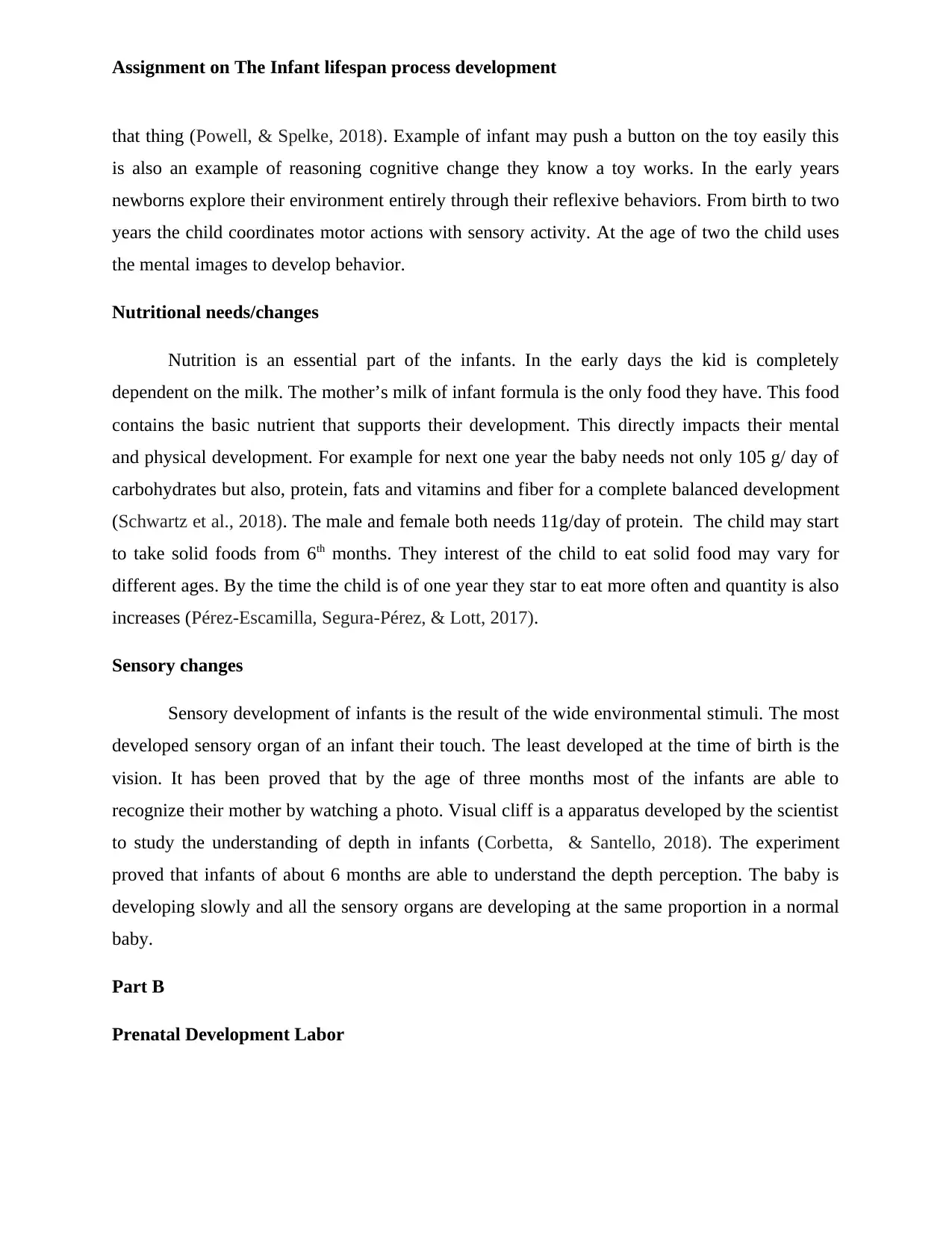
Assignment on The Infant lifespan process development
that thing (Powell, & Spelke, 2018). Example of infant may push a button on the toy easily this
is also an example of reasoning cognitive change they know a toy works. In the early years
newborns explore their environment entirely through their reflexive behaviors. From birth to two
years the child coordinates motor actions with sensory activity. At the age of two the child uses
the mental images to develop behavior.
Nutritional needs/changes
Nutrition is an essential part of the infants. In the early days the kid is completely
dependent on the milk. The mother’s milk of infant formula is the only food they have. This food
contains the basic nutrient that supports their development. This directly impacts their mental
and physical development. For example for next one year the baby needs not only 105 g/ day of
carbohydrates but also, protein, fats and vitamins and fiber for a complete balanced development
(Schwartz et al., 2018). The male and female both needs 11g/day of protein. The child may start
to take solid foods from 6th months. They interest of the child to eat solid food may vary for
different ages. By the time the child is of one year they star to eat more often and quantity is also
increases (Pérez-Escamilla, Segura-Pérez, & Lott, 2017).
Sensory changes
Sensory development of infants is the result of the wide environmental stimuli. The most
developed sensory organ of an infant their touch. The least developed at the time of birth is the
vision. It has been proved that by the age of three months most of the infants are able to
recognize their mother by watching a photo. Visual cliff is a apparatus developed by the scientist
to study the understanding of depth in infants (Corbetta, & Santello, 2018). The experiment
proved that infants of about 6 months are able to understand the depth perception. The baby is
developing slowly and all the sensory organs are developing at the same proportion in a normal
baby.
Part B
Prenatal Development Labor
that thing (Powell, & Spelke, 2018). Example of infant may push a button on the toy easily this
is also an example of reasoning cognitive change they know a toy works. In the early years
newborns explore their environment entirely through their reflexive behaviors. From birth to two
years the child coordinates motor actions with sensory activity. At the age of two the child uses
the mental images to develop behavior.
Nutritional needs/changes
Nutrition is an essential part of the infants. In the early days the kid is completely
dependent on the milk. The mother’s milk of infant formula is the only food they have. This food
contains the basic nutrient that supports their development. This directly impacts their mental
and physical development. For example for next one year the baby needs not only 105 g/ day of
carbohydrates but also, protein, fats and vitamins and fiber for a complete balanced development
(Schwartz et al., 2018). The male and female both needs 11g/day of protein. The child may start
to take solid foods from 6th months. They interest of the child to eat solid food may vary for
different ages. By the time the child is of one year they star to eat more often and quantity is also
increases (Pérez-Escamilla, Segura-Pérez, & Lott, 2017).
Sensory changes
Sensory development of infants is the result of the wide environmental stimuli. The most
developed sensory organ of an infant their touch. The least developed at the time of birth is the
vision. It has been proved that by the age of three months most of the infants are able to
recognize their mother by watching a photo. Visual cliff is a apparatus developed by the scientist
to study the understanding of depth in infants (Corbetta, & Santello, 2018). The experiment
proved that infants of about 6 months are able to understand the depth perception. The baby is
developing slowly and all the sensory organs are developing at the same proportion in a normal
baby.
Part B
Prenatal Development Labor
⊘ This is a preview!⊘
Do you want full access?
Subscribe today to unlock all pages.

Trusted by 1+ million students worldwide
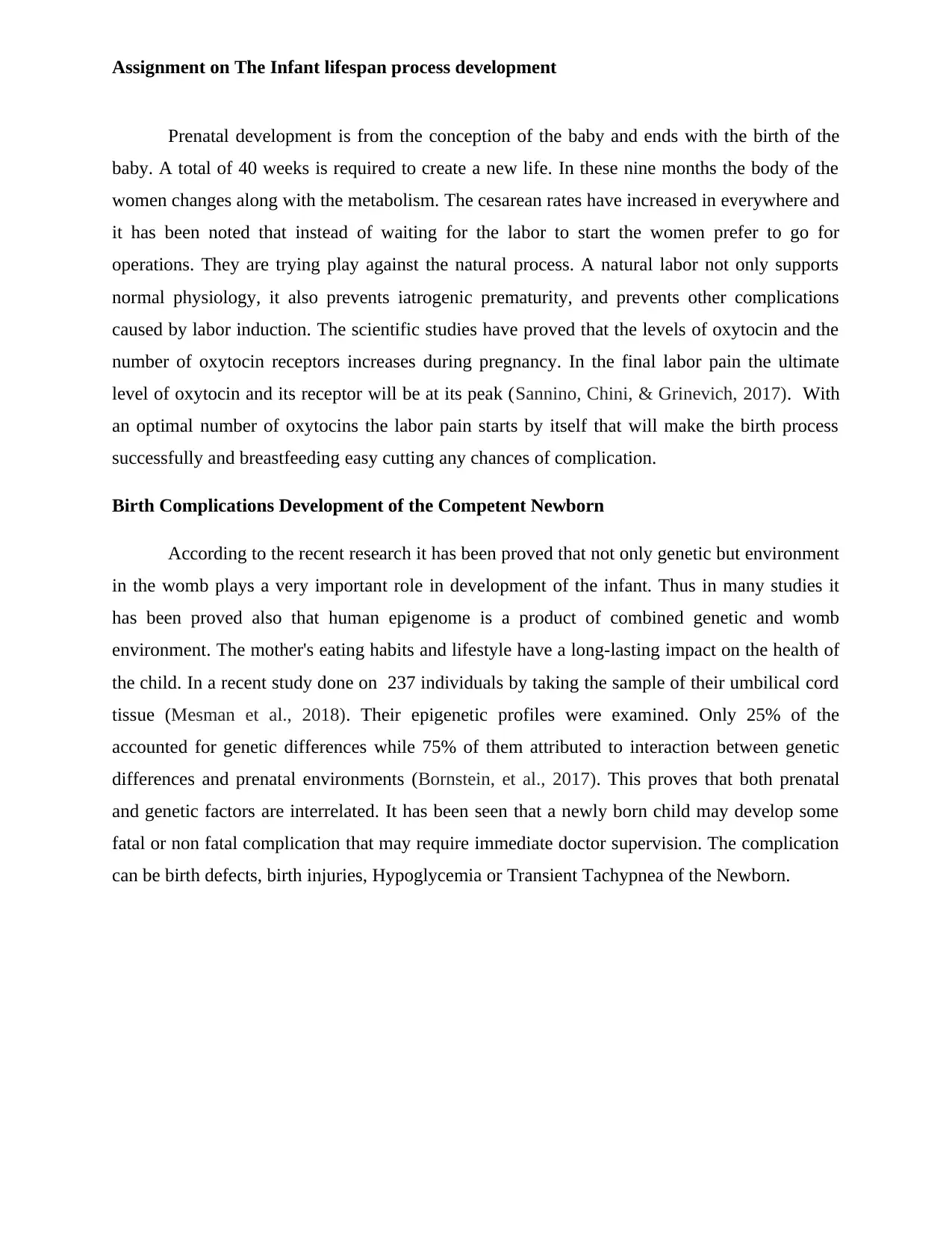
Assignment on The Infant lifespan process development
Prenatal development is from the conception of the baby and ends with the birth of the
baby. A total of 40 weeks is required to create a new life. In these nine months the body of the
women changes along with the metabolism. The cesarean rates have increased in everywhere and
it has been noted that instead of waiting for the labor to start the women prefer to go for
operations. They are trying play against the natural process. A natural labor not only supports
normal physiology, it also prevents iatrogenic prematurity, and prevents other complications
caused by labor induction. The scientific studies have proved that the levels of oxytocin and the
number of oxytocin receptors increases during pregnancy. In the final labor pain the ultimate
level of oxytocin and its receptor will be at its peak (Sannino, Chini, & Grinevich, 2017). With
an optimal number of oxytocins the labor pain starts by itself that will make the birth process
successfully and breastfeeding easy cutting any chances of complication.
Birth Complications Development of the Competent Newborn
According to the recent research it has been proved that not only genetic but environment
in the womb plays a very important role in development of the infant. Thus in many studies it
has been proved also that human epigenome is a product of combined genetic and womb
environment. The mother's eating habits and lifestyle have a long-lasting impact on the health of
the child. In a recent study done on 237 individuals by taking the sample of their umbilical cord
tissue (Mesman et al., 2018). Their epigenetic profiles were examined. Only 25% of the
accounted for genetic differences while 75% of them attributed to interaction between genetic
differences and prenatal environments (Bornstein, et al., 2017). This proves that both prenatal
and genetic factors are interrelated. It has been seen that a newly born child may develop some
fatal or non fatal complication that may require immediate doctor supervision. The complication
can be birth defects, birth injuries, Hypoglycemia or Transient Tachypnea of the Newborn.
Prenatal development is from the conception of the baby and ends with the birth of the
baby. A total of 40 weeks is required to create a new life. In these nine months the body of the
women changes along with the metabolism. The cesarean rates have increased in everywhere and
it has been noted that instead of waiting for the labor to start the women prefer to go for
operations. They are trying play against the natural process. A natural labor not only supports
normal physiology, it also prevents iatrogenic prematurity, and prevents other complications
caused by labor induction. The scientific studies have proved that the levels of oxytocin and the
number of oxytocin receptors increases during pregnancy. In the final labor pain the ultimate
level of oxytocin and its receptor will be at its peak (Sannino, Chini, & Grinevich, 2017). With
an optimal number of oxytocins the labor pain starts by itself that will make the birth process
successfully and breastfeeding easy cutting any chances of complication.
Birth Complications Development of the Competent Newborn
According to the recent research it has been proved that not only genetic but environment
in the womb plays a very important role in development of the infant. Thus in many studies it
has been proved also that human epigenome is a product of combined genetic and womb
environment. The mother's eating habits and lifestyle have a long-lasting impact on the health of
the child. In a recent study done on 237 individuals by taking the sample of their umbilical cord
tissue (Mesman et al., 2018). Their epigenetic profiles were examined. Only 25% of the
accounted for genetic differences while 75% of them attributed to interaction between genetic
differences and prenatal environments (Bornstein, et al., 2017). This proves that both prenatal
and genetic factors are interrelated. It has been seen that a newly born child may develop some
fatal or non fatal complication that may require immediate doctor supervision. The complication
can be birth defects, birth injuries, Hypoglycemia or Transient Tachypnea of the Newborn.
Paraphrase This Document
Need a fresh take? Get an instant paraphrase of this document with our AI Paraphraser
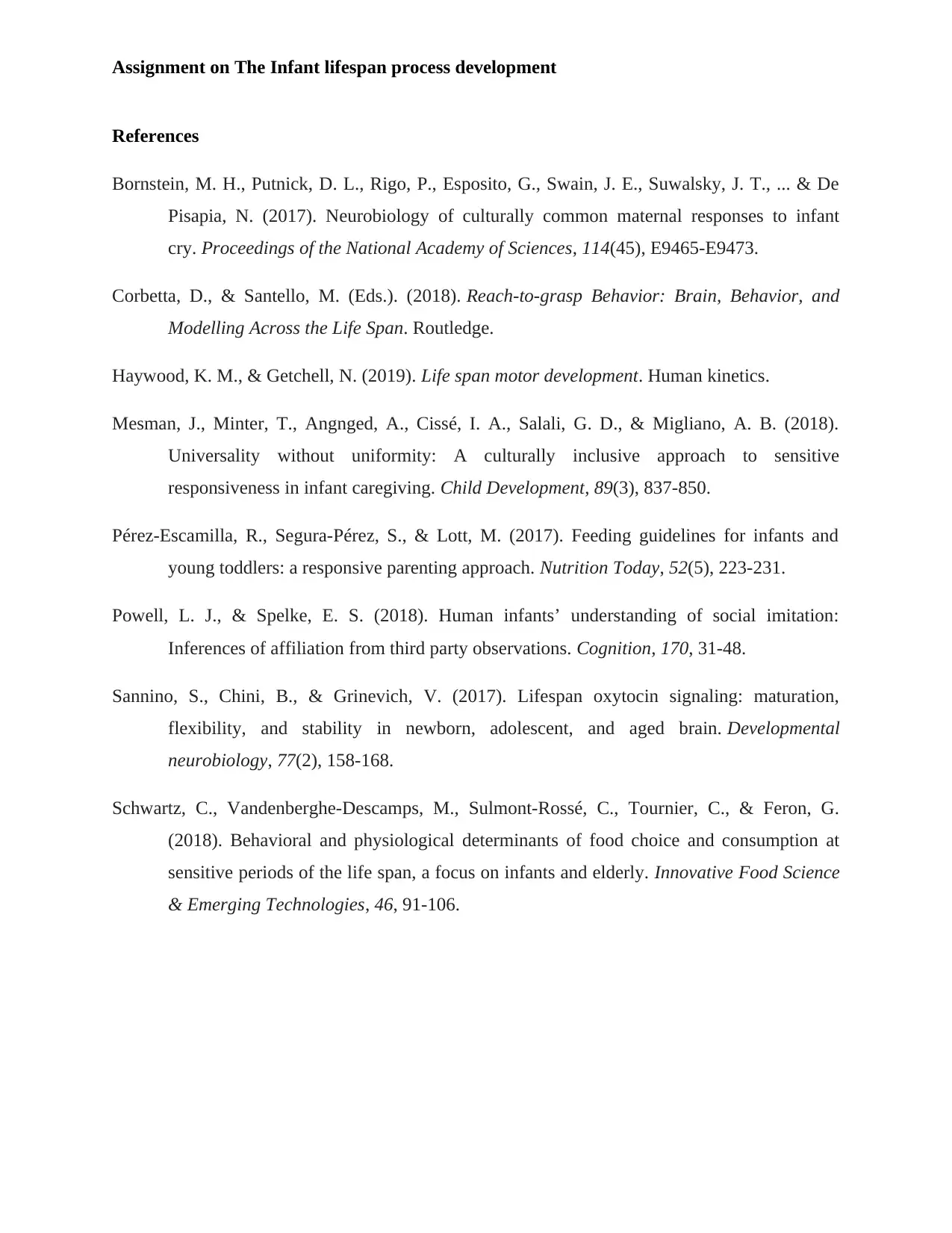
Assignment on The Infant lifespan process development
References
Bornstein, M. H., Putnick, D. L., Rigo, P., Esposito, G., Swain, J. E., Suwalsky, J. T., ... & De
Pisapia, N. (2017). Neurobiology of culturally common maternal responses to infant
cry. Proceedings of the National Academy of Sciences, 114(45), E9465-E9473.
Corbetta, D., & Santello, M. (Eds.). (2018). Reach-to-grasp Behavior: Brain, Behavior, and
Modelling Across the Life Span. Routledge.
Haywood, K. M., & Getchell, N. (2019). Life span motor development. Human kinetics.
Mesman, J., Minter, T., Angnged, A., Cissé, I. A., Salali, G. D., & Migliano, A. B. (2018).
Universality without uniformity: A culturally inclusive approach to sensitive
responsiveness in infant caregiving. Child Development, 89(3), 837-850.
Pérez-Escamilla, R., Segura-Pérez, S., & Lott, M. (2017). Feeding guidelines for infants and
young toddlers: a responsive parenting approach. Nutrition Today, 52(5), 223-231.
Powell, L. J., & Spelke, E. S. (2018). Human infants’ understanding of social imitation:
Inferences of affiliation from third party observations. Cognition, 170, 31-48.
Sannino, S., Chini, B., & Grinevich, V. (2017). Lifespan oxytocin signaling: maturation,
flexibility, and stability in newborn, adolescent, and aged brain. Developmental
neurobiology, 77(2), 158-168.
Schwartz, C., Vandenberghe-Descamps, M., Sulmont-Rossé, C., Tournier, C., & Feron, G.
(2018). Behavioral and physiological determinants of food choice and consumption at
sensitive periods of the life span, a focus on infants and elderly. Innovative Food Science
& Emerging Technologies, 46, 91-106.
References
Bornstein, M. H., Putnick, D. L., Rigo, P., Esposito, G., Swain, J. E., Suwalsky, J. T., ... & De
Pisapia, N. (2017). Neurobiology of culturally common maternal responses to infant
cry. Proceedings of the National Academy of Sciences, 114(45), E9465-E9473.
Corbetta, D., & Santello, M. (Eds.). (2018). Reach-to-grasp Behavior: Brain, Behavior, and
Modelling Across the Life Span. Routledge.
Haywood, K. M., & Getchell, N. (2019). Life span motor development. Human kinetics.
Mesman, J., Minter, T., Angnged, A., Cissé, I. A., Salali, G. D., & Migliano, A. B. (2018).
Universality without uniformity: A culturally inclusive approach to sensitive
responsiveness in infant caregiving. Child Development, 89(3), 837-850.
Pérez-Escamilla, R., Segura-Pérez, S., & Lott, M. (2017). Feeding guidelines for infants and
young toddlers: a responsive parenting approach. Nutrition Today, 52(5), 223-231.
Powell, L. J., & Spelke, E. S. (2018). Human infants’ understanding of social imitation:
Inferences of affiliation from third party observations. Cognition, 170, 31-48.
Sannino, S., Chini, B., & Grinevich, V. (2017). Lifespan oxytocin signaling: maturation,
flexibility, and stability in newborn, adolescent, and aged brain. Developmental
neurobiology, 77(2), 158-168.
Schwartz, C., Vandenberghe-Descamps, M., Sulmont-Rossé, C., Tournier, C., & Feron, G.
(2018). Behavioral and physiological determinants of food choice and consumption at
sensitive periods of the life span, a focus on infants and elderly. Innovative Food Science
& Emerging Technologies, 46, 91-106.
1 out of 5
Related Documents
Your All-in-One AI-Powered Toolkit for Academic Success.
+13062052269
info@desklib.com
Available 24*7 on WhatsApp / Email
![[object Object]](/_next/static/media/star-bottom.7253800d.svg)
Unlock your academic potential
Copyright © 2020–2025 A2Z Services. All Rights Reserved. Developed and managed by ZUCOL.





